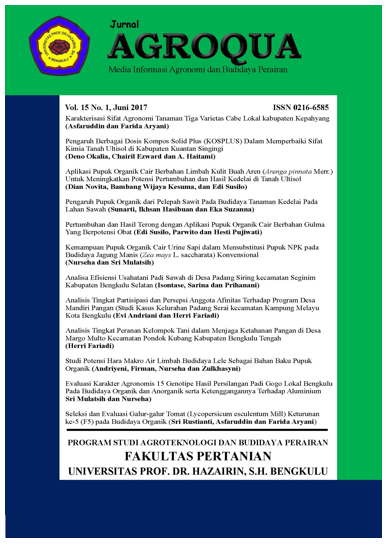KERAGAAN KEDELAI TERHADAP JENIS KOMPOS DAN DOSIS PUPUK UREA DI LAHAN PESISIR BENGKULU
DOI:
https://doi.org/10.32663/ja.v19i1.1794Keywords:
Coastal Land, Compost and Urea, Direng 1Abstract
One of the efforts to increase soybean production in Bengkulu is through the use of coastal land. Coastal land improvement is carried out by adding compost fertilizers. In order to meet the nutrient needs for soybean plants in coastal lands, a combination of compost and urea is needed. This study aims to determine the performance of soybean in the application of various types of compost and doses of urea and determine the type of compost and the best dose of urea in coastal lands. The study was conducted in July-August 2020. The study used a 2-factor and 3-replications in Completely Randomized Block Design, the first factor was the type of compost: P1 = Widelia trilobata; P2 = Tithonia diversivolia; P3 = oil palm empty bunches, P4 = water hyacinth. The second factor is the dose of Urea: N0 = 0 kg.ha-1, N1 = 25 kg.ha-1, N2 = 50 kg.ha-1, N3 = 75 kg.ha-1. The soybean used was the variety of Direng 1. The results showed that the type of compost and the dose of urea were not significantly different in the soybean plant performance variables. The application of 4 types of compost as much as 10 tons ha-1 in coastal lands showed poor growth and yield a little. Thitonia compost gives the highest yields of 0.5 ton.ha-1 and 0.48 ton.ha-1 when giving urea 75 kg.ha-1. Soybean yields are still very low, so it is necessary to double the dose of urea in coastal lands.
Keywords: Coastal Land, Direng 1, Compost and Urea.
References
Downloads
Published
Issue
Section
License
Authors who publish with this journal agree to the following terms:
- Authors grant the journal right of first publication with the work simultaneously licensed under a Creative Commons Attribution 4.0 Internasional (CC BY 4.0) Licence that allows others to use and share the work with an acknowledgment of the work's authorship and initial publication in this journal.
- The author(s) still hold the copyright of his/her/their work and retain publishing rights without restrictions such as (but not limited to) patent right, lecture, book and reproduce the article for own purposes.
















